Hoffman D.M., Singh B., Thomas J.H. (Eds). Handbook of Vacuum Science and Technology
Подождите немного. Документ загружается.

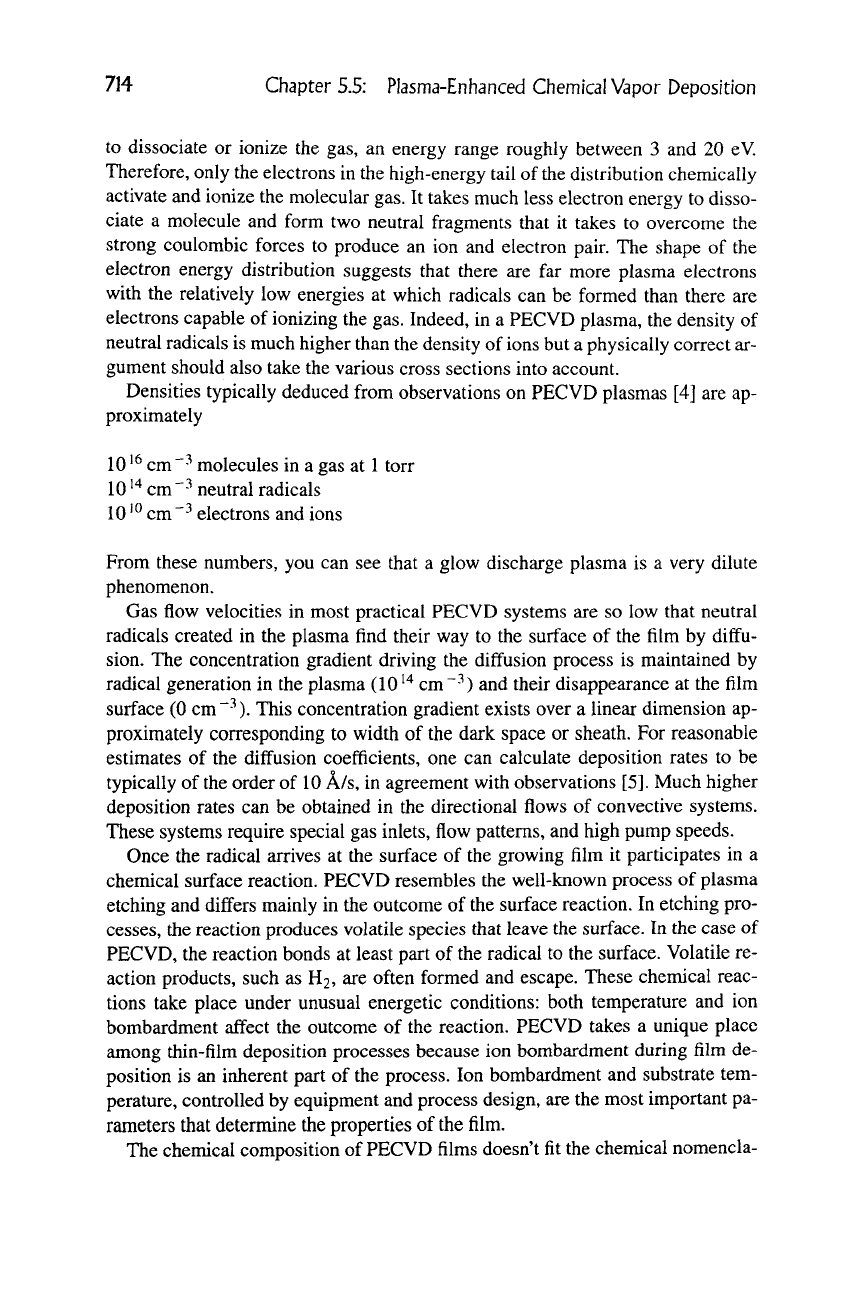
714 Chapter S.S: Plasma-Enhanced Chemical Vapor Deposition
to dissociate or ionize the gas, an energy range roughly between 3 and 20 eV.
Therefore, only the electrons in the high-energy tail of the distribution chemically
activate and ionize the molecular gas. It takes much less electron energy to disso-
ciate a molecule and form two neutral fragments that it takes to overcome the
strong coulombic forces to produce an ion and electron pair. The shape of the
electron energy distribution suggests that there are far more plasma electrons
with the relatively low energies at which radicals can be formed than there are
electrons capable of ionizing the gas. Indeed, in a PECVD plasma, the density of
neutral radicals is much higher than the density of ions but a physically correct ar-
gument should also take the various cross sections into account.
Densities typically deduced from observations on PECVD plasmas [4] are ap-
proximately
10 ^^
cm
~-^
molecules in a gas at
1
torr
10
^"^
cm~-^ neutral radicals
10 '^ cm~'^ electrons and ions
From these numbers, you can see that a glow discharge plasma is a very dilute
phenomenon.
Gas flow velocities in most practical PECVD systems are so low that neutral
radicals created in the plasma find their way to the surface of the film by diffu-
sion. The concentration gradient driving the diffusion process is maintained by
radical generation in the plasma (10
^^
cm~^) and their disappearance at the film
surface (0 cm~-^). This concentration gradient exists over a linear dimension ap-
proximately corresponding to width of the dark space or sheath. For reasonable
estimates of the diffusion coefficients, one can calculate deposition rates to be
typically of the order of 10 A/s, in agreement with observations [5]. Much higher
deposition rates can be obtained in the directional flows of convective systems.
These systems require special gas inlets, flow patterns, and high pump speeds.
Once the radical arrives at the surface of the growing film it participates in a
chemical surface reaction. PECVD resembles the well-known process of plasma
etching and differs mainly in the outcome of the surface reaction. In etching pro-
cesses, the reaction produces volatile species that leave the surface. In the case of
PECVD, the reaction bonds at least part of the radical to the surface. Volatile re-
action products, such as H2, are often formed and escape. These chemical reac-
tions take place under unusual energetic conditions: both temperature and ion
bombardment affect the outcome of the reaction. PECVD takes a unique place
among thin-film deposition processes because ion bombardment during film de-
position is an inherent part of the process. Ion bombardment and substrate tem-
perature, controlled by equipment and process design, are the most important pa-
rameters that determine the properties of the film.
The chemical composition of PECVD films doesn't fit the chemical nomencla-

S.5.1 Introduction
715
ture as being pure silicon, simple oxides, nitrides, carbon, or carbides. Films al-
ways contain fragments of the precursor ligand groups, usually hydrogen, hydro-
carbon groups, fluorine, or chlorine. Although this may be discomforting from a
chemical purist's view point, materials scientists have learned that these solids
have useful properties, often amazingly close to their chemically pure and stoi-
chiometric counterparts. Physicists have realized that an incorporated ligand group
such as hydrogen can make the difference between an interesting and technologi-
cally potent material such as a-Si:H, and its electronically less useful counterpart
a-Si. The process engineer manipulates temperature and ion bombardment to
control the incorporation of ligand groups and tailor the properties of the film. Al-
though many different material compositions fit the single designation of, e.g.,
plasma oxide or plasma nitride, Table 1 lists the most important materials de-
posited by PECVD.
The first commercial plasma reactors were developed in the early 1970s to de-
posit silicon nitride films [22]. Silicon nitride passivation layers replaced the sili-
con oxide/metal can packaging technology, used until then to encapsulate inte-
grated circuits, and enabled the use of plastic packaging. At about the same time,
high-resistivity hydrogenated amorphous silicon was shown to be amenable to
doping [23], analogous to crystalline silicon. The development of amorphous
Table
1
Examples of Materials Deposited by PECVD
Material
Made from
Semiconductors
Insulators
Conductors
Amorphous [6] and
polycrystalline silicon [7]
Silicon-germanium alloys [8]
p-
and ;z-type a-silicon [8]
Diamondlike carbon [9,10]
Diamond [9,10]
Plasma nitride [11]
Plasma oxide [11,12]
Silicon-carbon alloys [13]
Diamond, a- carbon [9,10]
Boron nitride [14,15]
Titanium oxide [16]
Aluminum oxide [17]
Tantalum oxide
[
18]
Copper
n -f silicon [21]
SiH4,
Si2He,
SiH4 + GeH4, GeF4
SiH4 + B2H(,orPH3
Hydrocarbon gases
CH4,
H2,
O2
SiH4 + (NH3, N2)
SiH4 + (N2O, O2) or
organosilane + oxidizer
SiH4 + hydrocarbon or
organosilane + hydrocarbon
Hydrocarbons, H2
B2H6 + NH3, borazine
Tetraisopropyltitanate + O2
Aluminum acetylacetonate -I- O2
Ta(C2H50)5
Copper acetylacetonate [19]
Copper )8-diketonates [20]
SiH4 -I- PH3
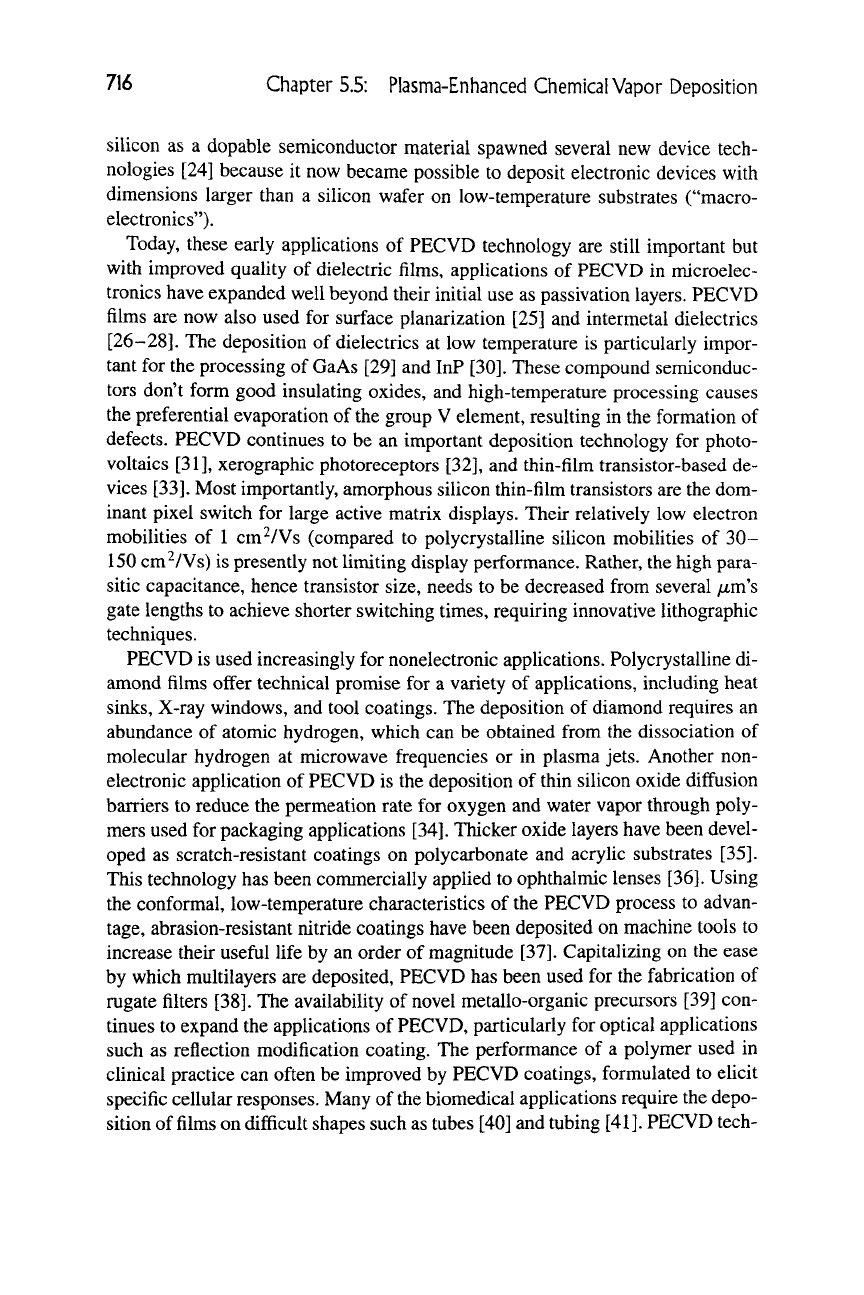
716 Chapter 5.5: Plasma-Enhanced Chemical Vapor Deposition
silicon as a dopable semiconductor material spawned several new device tech-
nologies [24] because it now became possible to deposit electronic devices with
dimensions larger than a silicon wafer on low-temperature substrates ("macro-
electronics")-
Today, these early applications of PECVD technology are still important but
with improved quality of dielectric films, applications of PECVD in microelec-
tronics have expanded well beyond their initial use as passivation layers. PECVD
films are now also used for surface planarization [25] and intermetal dielectrics
[26-28].
The deposition of dielectrics at low temperature is particularly impor-
tant for the processing of GaAs [29] and InP [30]. These compound semiconduc-
tors don't form good insulating oxides, and high-temperature processing causes
the preferential evaporation of the group V element, resulting in the formation of
defects. PECVD continues to be an important deposition technology for photo-
voltaics [31], xerographic photoreceptors [32], and thin-film transistor-based de-
vices [33]. Most importantly, amorphous silicon thin-film transistors are the dom-
inant pixel switch for large active matrix displays. Their relatively low electron
mobilities of 1 cm^/Vs (compared to polycrystalline silicon mobilities of 30-
150 cm^/Vs) is presently not limiting display performance. Rather, the high para-
sitic capacitance, hence transistor size, needs to be decreased from several
jmm's
gate lengths to achieve shorter switching times, requiring innovative lithographic
techniques.
PECVD is used increasingly for nonelectronic applications. Polycrystalline di-
amond films offer technical promise for a variety of applications, including heat
sinks.
X-ray windows, and tool coatings. The deposition of diamond requires an
abundance of atomic hydrogen, which can be obtained from the dissociation of
molecular hydrogen at microwave frequencies or in plasma jets. Another non-
electronic application of PECVD is the deposition of thin silicon oxide diffusion
barriers to reduce the permeation rate for oxygen and water vapor through poly-
mers used for packaging applications [34]. Thicker oxide layers have been devel-
oped as scratch-resistant coatings on polycarbonate and acrylic substrates [35].
This technology has been commercially applied to ophthalmic lenses [36]. Using
the conformal, low-temperature characteristics of the PECVD process to advan-
tage,
abrasion-resistant nitride coatings have been deposited on machine tools to
increase their useful life by an order of magnitude [37]. Capitalizing on the ease
by which multilayers are deposited, PECVD has been used for the fabrication of
rugate filters [38]. The availability of novel metallo-organic precursors [39] con-
tinues to expand the applications of PECVD, particularly for optical applications
such as reflection modification coating. The performance of a polymer used in
clinical practice can often be improved by PECVD coatings, formulated to elicit
specific cellular responses. Many of the biomedical applications require the depo-
sition of films on difficult shapes such as tubes [40] and tubing
[41].
PECVD tech-
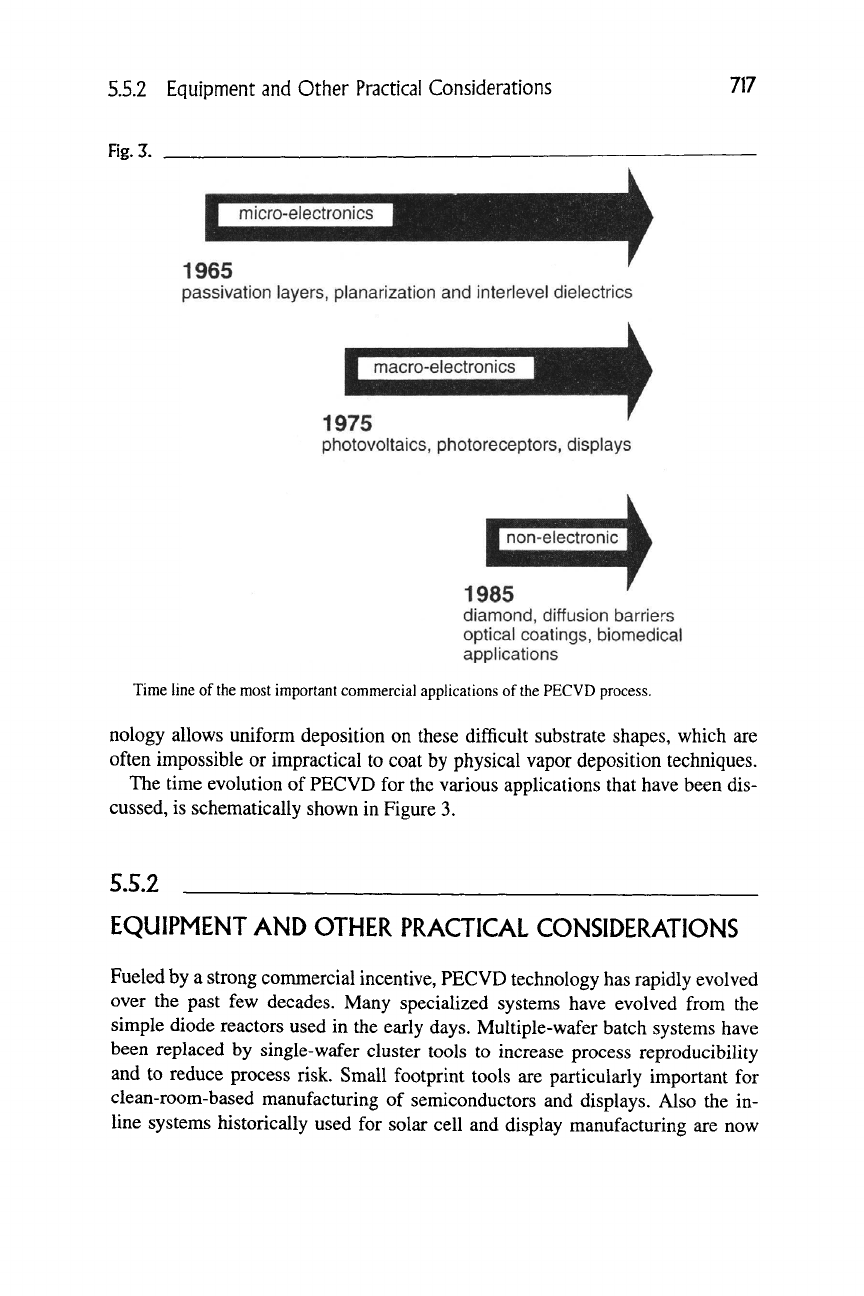
5.5.2 Equipment and Other Practical Considerations
717
Fig.
3.
1965
passivation layers, pianarizatlon and interlevel dielectrics
1975
photovoltaics, photoreceptors, displays
1985
diamond,
diffusion barriers
optical coatings, biomedical
applications
Time line of the most important commercial applications of the PECVD process.
nology allows uniform deposition on these difficult substrate shapes, which are
often impossible or impractical to coat by physical vapor deposition techniques.
The time evolution of PECVD for the various applications that have been dis-
cussed, is schematically shown in Figure 3.
5.5.2
EQUIPMENT AND OTHER PRACTICAL CONSIDERATIONS
Fueled by a strong commercial incentive, PECVD technology has rapidly evolved
over the past few decades. Many specialized systems have evolved from the
simple diode reactors used in the early days. Multiple-wafer batch systems have
been replaced by single-wafer cluster tools to increase process reproducibility
and to reduce process risk. Small footprint tools are particularly important for
clean-room-based manufacturing of semiconductors and displays. Also the in-
line systems historically used for solar cell and display manufacturing are now
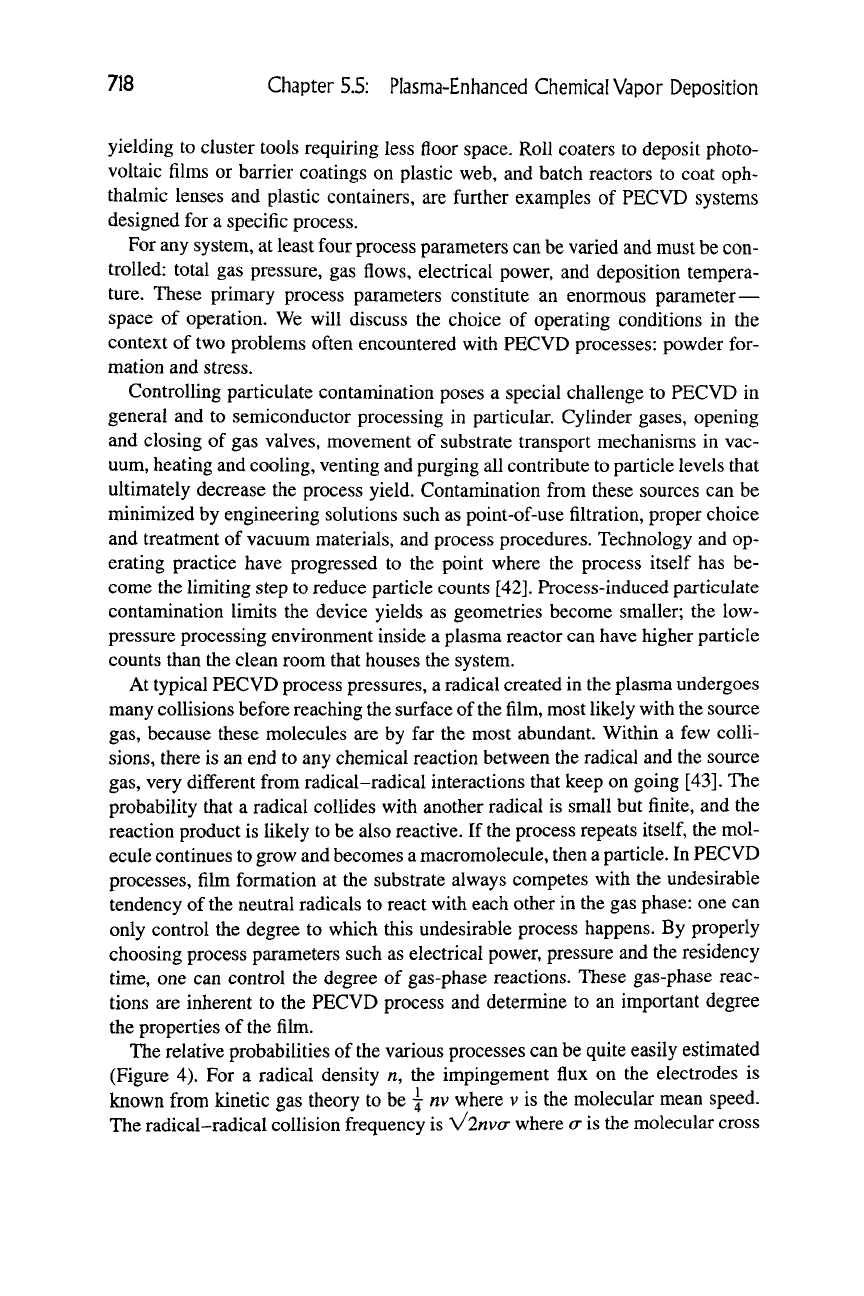
718 Chapter 5.5: Plasma-Enhanced Chemical Vapor Deposition
yielding to cluster tools requiring less floor space. Roll coaters to deposit photo-
voltaic films or barrier coatings on plastic web, and batch reactors to coat oph-
thalmic lenses and plastic containers, are further examples of PECVD systems
designed for a specific process.
For any system, at least four process parameters can be varied and must be con-
trolled: total gas pressure, gas flows, electrical power, and deposition tempera-
ture.
These primary process parameters constitute an enormous parameter—
space of operation. We will discuss the choice of operating conditions in the
context of two problems often encountered with PECVD processes: powder for-
mation and stress.
Controlling particulate contamination poses a special challenge to PECVD in
general and to semiconductor processing in particular. Cylinder gases, opening
and closing of gas valves, movement of substrate transport mechanisms in vac-
uum, heating and cooling, venting and purging all contribute to particle levels that
ultimately decrease the process yield. Contamination from these sources can be
minimized by engineering solutions such as point-of-use filtration, proper choice
and treatment of vacuum materials, and process procedures. Technology and op-
erating practice have progressed to the point where the process itself has be-
come the limiting step to reduce particle counts [42]. Process-induced particulate
contamination limits the device yields as geometries become smaller; the low-
pressure processing environment inside a plasma reactor can have higher particle
counts than the clean room that houses the system.
At typical PECVD process pressures, a radical created in the plasma undergoes
many collisions before reaching the surface of
the
film, most likely with the source
gas,
because these molecules are by far the most abundant. Within a few colli-
sions,
there is an end to any chemical reaction between the radical and the source
gas,
very different from radical-radical interactions that keep on going [43]. The
probability that a radical collides with another radical is small but finite, and the
reaction product is likely to be also reactive. If the process repeats
itself,
the mol-
ecule continues to grow and becomes a macromolecule, then a particle. In PECVD
processes, film formation at the substrate always competes with the undesirable
tendency of the neutral radicals to react with each other in the gas phase: one can
only control the degree to which this undesirable process happens. By properly
choosing process parameters such as electrical power, pressure and the residency
time,
one can control the degree of gas-phase reactions. These gas-phase reac-
tions are inherent to the PECVD process and determine to an important degree
the properties of the film.
The relative probabilities of the various processes can be quite easily estimated
(Figure 4). For a radical density n, the impingement flux on the electrodes is
known from kinetic gas theory to be j nv where v is the molecular mean speed.
The radical-radical collision frequency is Vlnva where a is the molecular cross
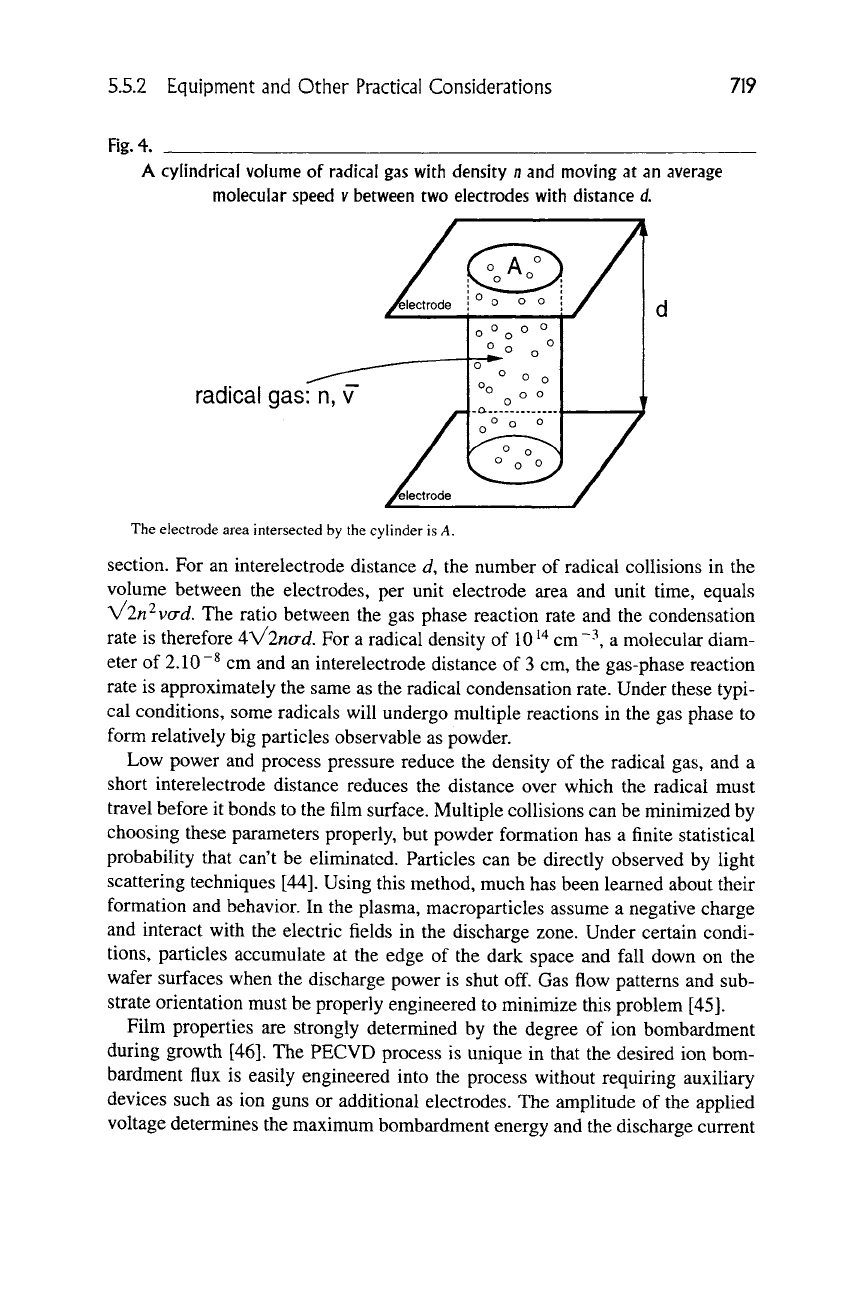
5.5.2 Equipment and Other Practical Considerations
719
Fig.
4.
A cylindrical volume of radical gas with density n and moving at an average
molecular speed v between two electrodes with distance d.
radical gas: n, v
The electrode area intersected by the cyUnder is A.
section. For an interelectrode distance d, the number of radical collisions in the
volume between the electrodes, per unit electrode area and unit time, equals
ylrO-vcrd. The ratio between the gas phase reaction rate and the condensation
rate is therefore
AVlnad.
For a radical density of
10 ^"^
cm~'\ a molecular diam-
eter of 2.10"^ cm and an interelectrode distance of 3 cm, the gas-phase reaction
rate is approximately the same as the radical condensation rate. Under these typi-
cal conditions, some radicals will undergo multiple reactions in the gas phase to
form relatively big particles observable as powder.
Low power and process pressure reduce the density of the radical gas, and a
short interelectrode distance reduces the distance over which the radical must
travel before it bonds to the film surface. Multiple collisions can be minimized by
choosing these parameters properly, but powder formation has a finite statistical
probability that can't be eliminated. Particles can be directly observed by light
scattering techniques [44]. Using this method, much has been learned about their
formation and behavior. In the plasma, macroparticles assume a negative charge
and interact with the electric fields in the discharge zone. Under certain condi-
tions,
particles accumulate at the edge of the dark space and fall down on the
wafer surfaces when the discharge power is shut off. Gas flow patterns and sub-
strate orientation must be properly engineered to minimize this problem [45].
Film properties are strongly determined by the degree of ion bombardment
during growth [46]. The PECVD process is unique in that the desired ion bom-
bardment flux is easily engineered into the process without requiring auxiliary
devices such as ion guns or additional electrodes. The amplitude of the applied
voltage determines the maximum bombardment energy and the discharge current

720
Chapter 5.5: Plasma-Enhanced Chemical Vapor Deposition
Fig.
5.
surface bonding processes
ion bombardment
compressive stress
film
substrate
(a) Surface-bonding processes during film growth, as well as annealing and hydrogen evolu-
tion after the film has been formed, induces tensile stress; (b) ion bombardment reduces the
tensile stress and may induce compressive stress.
is a measure for the ion flux. Both frequency of the applied power [47] and the
gas pressure [48] affect ion energy and flux in predictable ways. Ion bombard-
ment during deposition at low temperatures yields film properties similar to high-
temperature material deposited without bombardment. Ion bombardment, how-
ever, induces compressive stress in the film—see Figure 5(b)—because the film
wants to occupy more space than the substrate allows. When for thick films the
compressive force (stress X film thickness) exceeds the forces of adhesion at the
interface with
a
rigid substrate, adhesion failure catastrophically relieves the stress.
Without ion bombardment, many amorphous films exhibit tensile stress. Tensile
stresses—Figure
5(a)
—
are
often related to the formation of strained surface
bonds formed during film growth. Hydride films often exhibit tensile stress after
they have been heated above their temperature of deposition. The stress is caused
by hydrogen evolution, causing film densification and often film cracking. Long
before these unhappy endings, excessively high stresses (»10^ dynes/cm^)
cause many problems in thin-film devices and components, such as substrate de-
formation, cracking, void formation, enhanced electromigration, and piezoelec-
tric charging effects. Understanding the relation of these stresses to the process
parameters is key to the successful application of PECVD technology.
Synmietric reactors have the same ion bombardment on both electrodes, con-
sequently the material harvested from both electrodes is the same. Most plasma
reactors are puiposely designed asymmetric to maximize or minimize the degree
of ion bombardment. However, about half the material deposited in these aniso-
tropic processing environments is lost. An asymmetric reactor design often has
a large grounded electrode and a capacitively coupled powered electrode. In this
configuration, the grounded electrode is subject to minimum ion bombardment
and the small powered electroded receives high ion bombardment.
Dense and hard materials are deposited under conditions of high bombardment

5.5.2 Equipment and Other Practical Considerations 721
flux and energy. These conditions are found at the cathode of DC systems and at
the powered electrode of
a
capacitively coupled RP system. Ion bombardment can
be tempered by decreasing the discharge power to the process, increasing the fre-
quency or the process pressure.
At low frequencies an ion can traverse the dark space during one half-period.
Now the pressure is the main parameter to temper the ion energy, and the pressure
ultimately determines if
a
film will be deposited or sputtered away. The maximum
bombardment energy is the voltage amplitude. With increasing pressure, the av-
erage ion bombardment energy decreases due to intermolecular collisions; the ion
bombardment flux, however, increases. If the frequency is higher than the corre-
sponding time that it takes an ion to traverse the sheath, the ion bombardment en-
ergy also decreases [49]. The reason for this is that for a fraction of the cycle the
ions are accelerated by the relatively low plasma potential rather than the cathode
potential. Independent control over flux and energy is obtained in mixed-frequency
deposition systems. In these systems, the plasma density (ion flux) is primarily
determined by the high-frequency component and the bombardment (ion energy)
is determined by the low-frequency bias [50].
Many device applications require minimum bombardment during growth. In-
terfacial charge trapping and electronic defect states in the bulk are often related
to bonding defects due to ion damage. Low power, high pressure, and high fre-
quencies are process conditions limiting the energy flux to substrates attached to
a large grounded electrode of a capacitively coupled system. The bombardment
energy on the grounded electrode is the average plasma potential, usually low for
this system configuration [51]. Inserting a grid electrode to create a field-free re-
gion (triode system), can further decrease the bombardment energy if plasma po-
tentials are unacceptably high.
So far we have assumed that the substrates aie attached to one of the electrodes
or are immersed in the plasma and electrically floating. In cither case the film sur-
face is exposed to the energetic plasma. Ion bombardment, ultraviolet light, and
metastable atoms are capable of inducing structural changes that result in film
densification and also in bonding defects. Defect centers act as electronic traps,
degrading charge transport, photoconductivity, and interfacial charge densities.
Similarly to plasma-assisted etching, ion bombardment during deposition affects
the conformality of the film around steps and in trenches
[52].
At high ion energies,
resputtering of less dense material avoids "breadloafing" at the top of trenches.
Depending on the application, anisotropy may or may not be desirable. Several
plasma deposition methods, permitting some control over the process have been
developed. These methods are schematically shown in Figure 6.
The simplest change is to move the substrate away from the energetic plasma —
see Figure 6(a). In addition, one can change the way in which the precursor gases
are chemically activated by moving the gas inlet of the condensable gas out of the
plasma zone—Figure 6(b). Both these methods are referred to in the literature
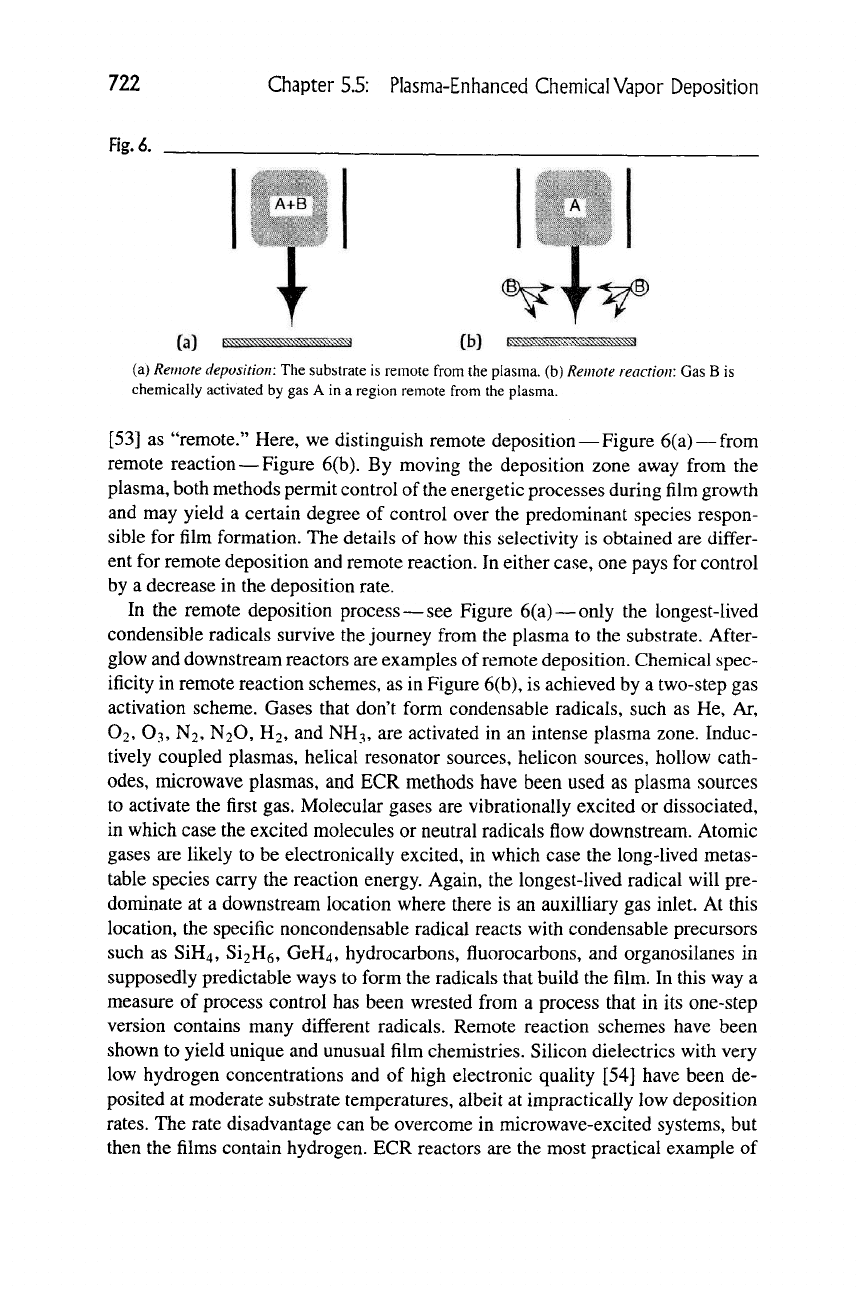
722 Chapter 5.5: Plasma-Enhanced Chemical Vapor Deposition
Fig.
6.
S^^m$
I I :iM^i:
"VtV®
(a) Remote deposition: The substrate is remote from the plasma, (b) Remote reaction: Gas B is
chemically activated by gas A in a region remote from the plasma.
[53] as "remote." Here, we distinguish remote deposition — Figure
6(a)
— from
remote reaction — Figure 6(b). By moving the deposition zone away from the
plasma, both methods permit control of
the
energetic processes during film growth
and may yield a certain degree of control over the predominant species respon-
sible for film formation. The details of how this selectivity is obtained are differ-
ent for remote deposition and remote reaction. In either case, one pays for control
by a decrease in the deposition rate.
In the remote deposition process —
see
Figure
6(a)
— only the longest-lived
condensible radicals survive the journey from the plasma to the substrate. After-
glow and downstream reactors are examples of remote deposition. Chemical spec-
ificity in remote reaction schemes, as in Figure 6(b), is achieved by a two-step gas
activation scheme. Gases that don't form condensable radicals, such as He, Ar,
O2,
O3, N2, N2O, H2, and NH3, are activated in an intense plasma zone. Induc-
tively coupled plasmas, helical resonator sources, helicon sources, hollow cath-
odes,
microwave plasmas, and ECR methods have been used as plasma sources
to activate the first gas. Molecular gases are vibrationally excited or dissociated,
in which case the excited molecules or neutral radicals flow downstream. Atomic
gases are likely to be electronically excited, in which case the long-lived metas-
table species carry the reaction energy. Again, the longest-lived radical will pre-
dominate at a downstream location where there is an auxilliary gas inlet. At this
location, the specific noncondensable radical reacts with condensable precursors
such as SiH4, Si2H6, GeH4, hydrocarbons, fluorocarbons, and organosilanes in
supposedly predictable ways to form the radicals that build the film. In this way a
measure of process control has been wrested from a process that in its one-step
version contains many different radicals. Remote reaction schemes have been
shown to yield unique and unusual film chemistries. Silicon dielectrics with very
low hydrogen concentrations and of high electronic quality [54] have been de-
posited at moderate substrate temperatures, albeit at impractically low deposition
rates.
The rate disadvantage can be overcome in microwave-excited systems, but
then the films contain hydrogen. ECR reactors are the most practical example of
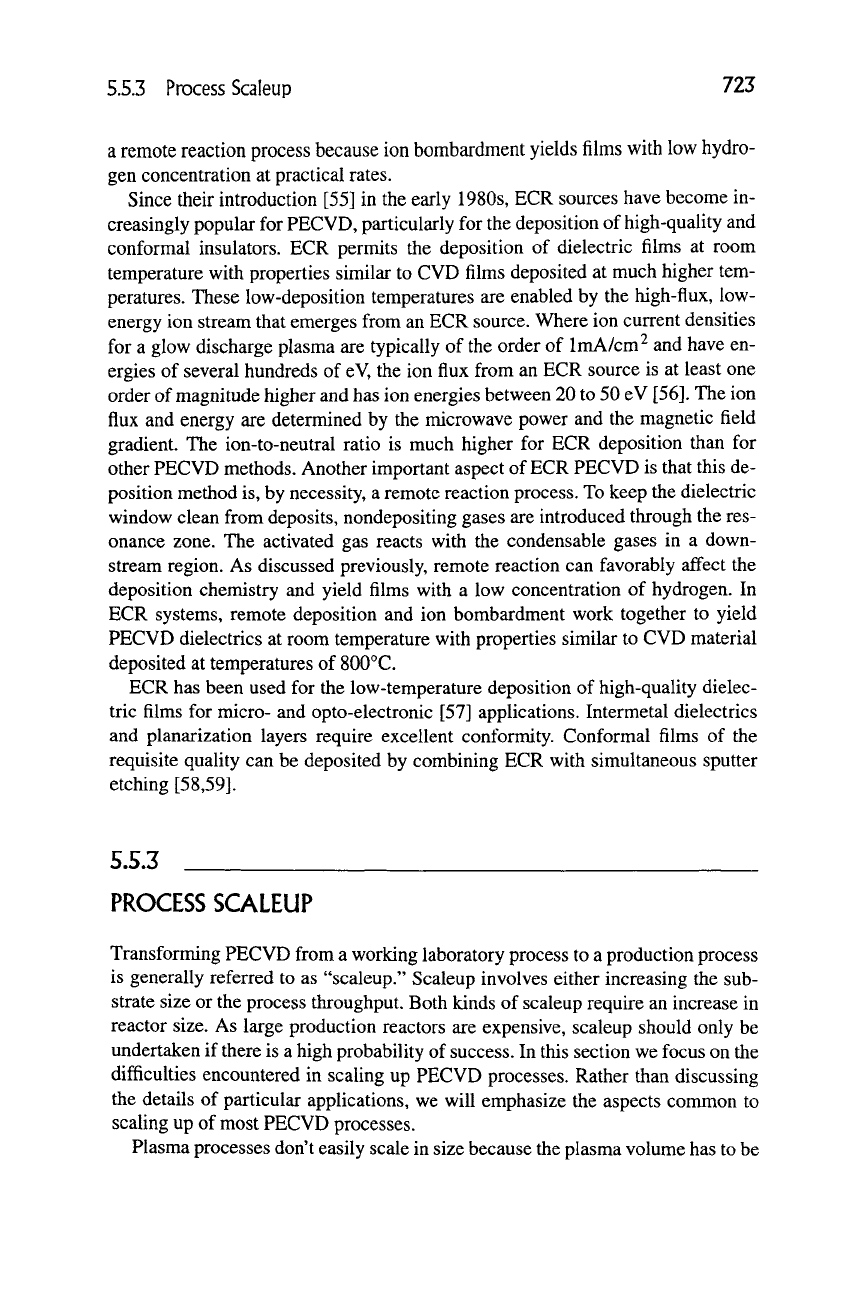
S.S.3 Process Scaleup 723
a remote reaction process because ion bombardment yields films with low hydro-
gen concentration at practical rates.
Since their introduction [55] in the early 1980s, ECR sources have become in-
creasingly popular for PECVD, particularly for the deposition of high-quality and
conformal insulators. ECR permits the deposition of dielectric films at room
temperature with properties similar to CVD films deposited at much higher tem-
peratures. These low-deposition temperatures are enabled by the high-flux, low-
energy ion stream that emerges from an ECR source. Where ion current densities
for a glow discharge plasma are typically of the order of ImA/cm^ and have en-
ergies of several hundreds of
eV,
the ion flux from an ECR source is at least one
order of magnitude higher and has ion energies between 20 to 50 eV
[56].
The ion
flux and energy are determined by the microwave power and the magnetic field
gradient. The ion-to-neutral ratio is much higher for ECR deposition than for
other PECVD methods. Another important aspect of ECR PECVD is that this de-
position method is, by necessity, a remote reaction process. To keep the dielectric
window clean from deposits, nondepositing gases are introduced through the res-
onance zone. The activated gas reacts with the condensable gases in a down-
stream region. As discussed previously, remote reaction can favorably affect the
deposition chemistry and yield films with a low concentration of hydrogen. In
ECR systems, remote deposition and ion bombardment work together to yield
PECVD dielectrics at room temperature with properties similar to CVD material
deposited at temperatures of 800°C.
ECR has been used for the low-temperature deposition of high-quality dielec-
tric films for micro- and opto-electronic [57] applications. Intermetal dielectrics
and planarization layers require excellent conformity. Conformal films of the
requisite quality can be deposited by combining ECR with simultaneous sputter
etching [58,59].
5.5.3
PROCESS SCALEUP
Transforming PECVD from a working laboratory process to a production process
is generally referred to as "scaleup." Scaleup involves either increasing the sub-
strate size or the process throughput. Both kinds of scaleup require an increase in
reactor size. As large production reactors are expensive, scaleup should only be
undertaken if there is a high probability of
success.
In this section we focus on the
difficulties encountered in scaling up PECVD processes. Rather than discussing
the details of particular applications, we will emphasize the aspects conunon to
scaling up of most PECVD processes.
Plasma processes don't easily scale in size because the plasma volume has to be
